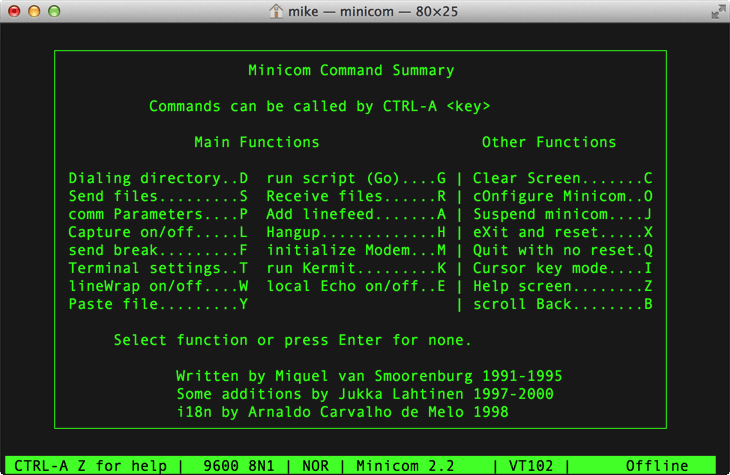

If it is a direct serial connection, the output will be something like this: console enabled In order to find the name of your port(s) enter this command in terminal: dmesg | grep tty
Install minicom install#
Install the program with: sudo apt-get install minicomĪlternatively, you can get Minicom via the Synaptic Package Manager. It is used to talk to external RS-232 devices such as mobile phones, routers, and serial console ports.

(It's a great addition to your Go Bag.Minicom is a text-based serial port communications program. * A Pi Zero can be configured to do a lot more than just act as a serial bridge. * You may already have a Pi Zero laying around. * This is more complicated (but a great learning opportunity) (Don't forget to cross RX/TX as abeck mentions.) This is small enough to easily fit in a bag's pocket for easy traveling. If you use a Zero W with no headers you can solder three wires to it with a triple header socket on the other end. To connect to a Serial Gadget, instead run minicom on the laptop to connect to the second Pi, then run minicom to connect to the actual target (and be reminded of "Inception"). With an Ethernet connection, ssh to the second Pi and run minicom in the session. Even simpler, set up the Pi Zero as a Serial Gadget (doesn't require a Zero W, a plain old Zero will work) Set up the Pi Zero as an Ethernet Gadget (laptop will see Zero as USB Ethernet device when connected)ģb. But for me the real winner is to set a Pi Zero up as a USB Gadgetģa. Configure the second Pi as a Wi-Fi access point you can connect to with your laptopģ. Add USB network adapter to the second Pi and use an Ethernet cableĢ. To allow a network connection from your laptop to the second Pi, you have a few choices:ġ. The second Pi will need USB power, which for a Zero you should be able to get from your laptop. The goal is to ssh from laptop to this second Pi then use it's serial connection. You can run the second Raspberry Pi headless, say, a Zero W. But maybe you don't have a USB serial adapter handy, but do have a spare (second) Raspberry Pi. Update: I also forgot to mention-it's possible to get output from the Pi's own bootloader (at an even earlier stage) using the BOOT_UART option supplied to a custom EEPROM build see cleverca22's post in the Pi Forums for details. I've done this process a few times in the past, but I've grown tired of looking back at old notes to remember specifically which pins to use on the GPIO, since I don't do it that often and the pins are unlabeled on most Pis. See also: Adafruit's guide to using a serial console on the Pi. Note: To exit the screen session, press Ctrl-A, then Ctrl-K, and confirm you want to exit. Note: In metacom, the Meta key is mapped to 'Esc' by default, at least on macOS.
Install minicom mac#
There are a number of ways to interact with the serial console on a Mac (and most are the same as on Linux, with sometimes minor usage differences), but the two I've used in the past are minicom and screen. That's the device you'll connect to on your Mac.

Open a terminal window on your Mac, and run ls /dev | grep usb Plug the USB to serial adapter into the pins as pictured below on the Pi (Black to GND, White to GPIO 14/pin 8 (UART TX), and Green to GPIO 15/pin 10 (UART RX)): Save that change, eject the microSD card, and stick the card back into the Pi.Pop the Pi's microSD card into another computer, edit the config.txt file inside the boot volume, and add the following line at the bottom: enable_uart=1.I bought the Adafruit 954 USB-to-TTL Serial Cable. If you want to access the Pi's serial console, here's what you need to do: Simply Embedded has a great overview of UART if you want to learn more. Many devices-including things like storage controller cards, which in a sense run their own internal operating system on an SoC-have a 'UART header', which is typically three or four pins that can connect over the RS-232 standard (though many do not operate at 12v like a traditional serial port! Use a USB-to-TTL adapter like the one I mention below). The Raspberry Pi can output information over a 'serial console', technically known as a UART (Universal Asynchronous Receiver/Transmitter). Or maybe you're like me, and someone 'accidentally' cut your Raspberry Pi in half, and you want to see what it's doing since it won't boot anymore. Or you don't have an HDMI display, and you can't log into your Pi via SSH. Or it'll boot, but it'll do weird things.


 0 kommentar(er)
0 kommentar(er)
